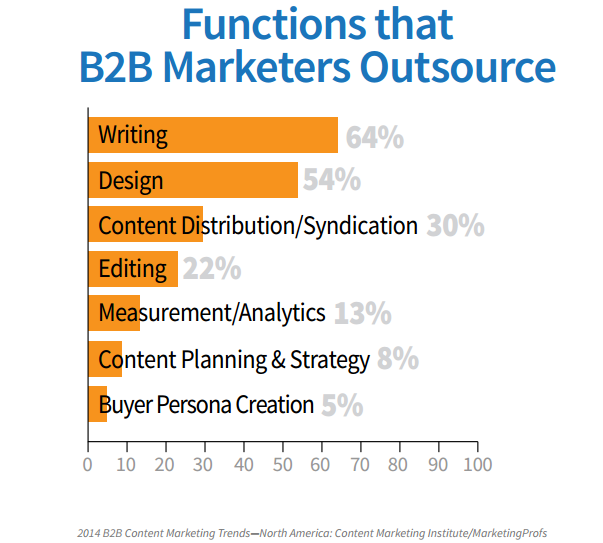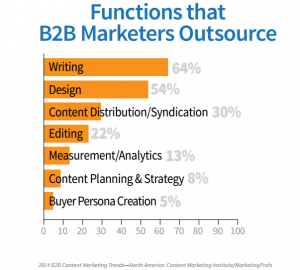
by Fronetics | Apr 21, 2014 | Blog, Content Marketing, Logistics, Marketing, Strategy, Supply Chain
When it comes to content your company doesn’t need to go it alone. Not only is it possible to outsource content, for many companies it may be the best solution. Here is how to determine if outsourcing content is right for your company, and what your company needs to consider when looking for an outsource partner.
Is outsourcing right for you?
Outsourcing is not the panacea. It may be the right solution for your company – or maybe not. Here is what to consider when determining if outsourcing content is the right solution for your company:
- What are your company’s core competencies?
- How can your company deliver the best value to your customers?
- A successful content strategy needs to be deliberate and needs to have someone in charge. Do you have in-house talent who can put together a content strategy for your company and manage the execution of the strategy?
- Does your company have in-house talent that can consistently create good content?
- Does your company have in-house talent that has the time to consistently create good talent?
- Does your company have in-house talent that can distribute your company’s content?
- Does your company have in-house talent that can track and analyze your company’s content strategy?
Be honest. Cobbling together staff or passing content like a hot potato from one person to another is not going to be effective. If content is not an area where your company excels, or if content could be carried out more efficiently and effectively if the service was outsourced – start looking for an outsource partner.
If you do decide that outsourcing is right for your company, know that you are not alone. Forty-four percent of B2B marketers report that they outsource content creation. Diving down further, 72 percent of large B2B companies (1,000 employees or more) outsource content creation and 34 percent of small B2B companies (10 to 99 employees) outsource content creation. Looking specifically at the manufacturing industry – 55 percent of manufacturing marketers report that they outsource content creation.
As shown in Figure 1 the content functions that B2B marketers outsource vary from writing to design to distribution to creating a buyer persona. When it comes to outsourcing content functions it doesn’t need to be the kitchen sink.
Figure 1

What to look for in an outsource partner
When it comes to finding an outsource partner you want to find a partner that will bring value to your company and to your customers. Whether you outsource all content functions or just one, here is what to look for in an outsource partner:
- Experience and knowledge of your industry;
- Willing to work with your company to help you achieve your goals;
- Open to exploring and furthering your company’s creative ideas;
- Able to follow instructions and execute with minimal oversight;
- Able to create the type of content your company needs;
- Interested in entering into a long-term relationship.
More generally, Frank Cavallaro wrote that when choosing your perfect outsource mate it is important to start by looking at the mission or value statement of your potential partner. Are these aligned to your company’s? If they are, move on and explore the partnership further. If not, walk away. “Mission and value statements speak to the core culture of the company, so if you can’t find common ground here, it is unlikely you will be able to build a positive working relationship.”
This post was originally published on DC Velocity.
by Fronetics | Apr 16, 2014 | Blog, Marketing, Social Media
For every blog post, tweet, and Facebook update, you should ask yourself: Who is listening?
Without a comprehensive social media strategy, your message may be getting lost in the chatter. There are a number of tools that will help you monitor your online influence and, effectively, make the necessary adjustments to ensure your efforts are paying off.
Here are 10 free tools to help you measure your social media ROI. The basic features of each of these tools are free.
1. Hootsuite
Considered one of the top social media management systems, Hootsuite is a web-based dashboard that enables your business or organization to execute campaigns across multiple social networks. This tool helps you identify audiences, distribute targeted messages, launch marketing campaigns, streamline workflow and much more. It also provides weekly reports on your social analytics. Social network integrations include, among others, Facebook, Twitter, LinkedIn, and Google+.
2. Facebook Insights
Sometimes the best analytics tools are built into the platform, like Facebook Insights. After your Facebook page receives at least 30 likes, Insights can be applied to break down the metrics of your content. See how people discover and respond to your posts and use the anonymized demographic data to analyze trends and tailor your message.
3. Google Analytics
By using Google Analytics you will have access to a wealth of strategic data across multiple venues such as ads, videos, websites, tablets, smartphones and social tools. The result is a complete profile of your potential customers and their needs. Learn, for example, how visitors find your site, what they like and don’t like, and what they technology they use to access the information.
4. TweetDeck
TweetDeck resembles Hootsuite but is exclusively focused on your engagements on Twitter. This real-time tracking and organizing tool allows you to customize your Twitter experience in one interface. You can manage multiple accounts, build timelines, and track hashtags, events, and topics.
5. SumAll
SumAll connects you to all the services you use in one interactive chart. SumAll enables you to monitor and measure more than 30 services (e.g. Facebook, Twitter, Instagram, PayPal, Google Analytics) – for free. SumAll is a great option for small and medium sized businesses who want to be able to monitor all of their platforms in one spot – and have reports delivered via email on a daily basis.
6. Twazzup
An ideal tool for those new to Twitter, Twazzup enables you to follow a real-time stream of updates about keywords of your choosing. The interface presents a clear look at your related real-time tweets as well as trending and user information. It also identifies the top influencers in your field.
7. IceRocket
Specializing in displaying the most up-to-the-second search results, IceRocket covers blogs, the web, Twitter, and Facebook. Find out who links to your blog posts and search the IceRocket database of 200 million blogs. Your monitoring results can be viewed on a single, easily digestible page.
8. Klout
How influential are you online? The so-called “Klout score” reveals your effectiveness on Twitter, Facebook, Google+, LinkedIn, Foursquare, Wikipedia, and Instagram. The company recently added business analytics to its list of services to assist users learn more about their online audiences.
9. HowSociable
HowSociable measures the impact of your brand across multiple social media platforms, helping you identify which one is the best fit for you. By analyzing the metrics of your presence on 36 popular social media sites, this tool produces a score between 1 and 10 to indicate the activity around your brand during a given week.
10. Addictomatic
Addictomatic is a straight-forward application to monitor your brand’s reputation and industry developments. Simply select your keywords and Addictomatic will scan a variety of platforms such as Google, Bing, Twitter, WordPress, YouTube and Flickr.

by Fronetics | Apr 15, 2014 | Blog, Content Marketing, Marketing, Social Media, Strategy

When it comes to content, a strategy is essential for success
A 2014 study found that 93 percent of B2B marketers use content marketing and that there is a significant difference in the effectiveness of content marketing if a strategy is in place – 60 percent of companies who have a documented content strategy in place consider their efforts to be effective as compared to 11 percent of companies with no documented content strategy in place. Similarly, the study found that companies who put a person in charge of content marketing were more likely to be successful than those who did not (86 percent vs. 46 percent).
In short, the majority of companies do not have a strategy in place despite the fact that companies are budgeting for and creating content and, that those who have a documented content strategy in place are more effective than companies who do not have a strategy in place. If your company is going to be effective at using content to drive profitable customer action, your company needs to have a strategy in place. Arjun Basu wisely said: “Without strategy, content is just stuff, and the world has enough stuff.”
Here are 11 steps to a content strategy.
1. Put someone in charge
If you want your company’s content strategy to be effective, you need to put someone in charge. Make sure they are in charge not just in name, but also in execution. That is, make sure the person in charge is given the authority to execute the strategy.
2. Define your goals
Why does your company want to create content? Do you want to shorten your sales cycle? Increase leads? You don’t want your content to be just stuff. You don’t want content to be ineffective. Therefore it is important to define what it is you want your content to do for your company.
3. Define your audience
Who is your audience? Create a persona. Take your time. Be honest. If you identify and define your audience correctly you will be more likely to reach your target audience and engage them than if you get this step wrong.
4. Define your metrics
Determine how you are going to track and measure success. Determine the metrics that you are going to track on a daily, weekly, monthly, and yearly basis.
5. Identify the right distribution channels
When it comes to content, distribution is essential – your content will not reach your target audience and will not be read unless it is distributed. Take the time to identify the distribution channels that are right fit for your company, your content, and your goals.
6. Create a publishing calendar
A publishing or editorial calendar provides you with a framework to create and distribute content. It helps you create content that is consistent, that is quality, and is tailored to your company’s goals. It is also helpful in terms of managing workflows, meeting deadlines, and managing writer’s block.
7. Create content
Valuable and relevant content is not a sales pitch. It is not content that pushes your products and services. Rather, it is content that communicates valuable information to customers and prospects so that they have the knowledge to make better informed decisions. Moreover, it is content that establishes your business as a reliable source of knowledge – as the thought-leader within the industry. Be thoughtful when you create content.
8. Distribute your content
Distribute your content via your target distribution channels. Distribute the content consistently over time and at the right time.
9. Engage with customers and prospects
Once your content has been distributed, engage with your audience. Respond to comments, respond to questions, and provide clarification. Make your content more than words – make it a relationship.
10. Track and analyze your metrics
Track and analyze your metrics on a daily, weekly, monthly, and annual basis. Take a look at what is working and what is not. By tracking and analyzing your metrics you can see, for example, what type of content is most effective and which distribution channels are helping you achieve your goals.
11. Make adjustments as needed
Your strategy should not be set in stone. Your strategy should be flexible. Look at your metrics, look at the feedback you are getting through your engagement with customers and prospects – make adjustments to your strategy as needed.
Remember that when it comes to content it is important to think marathon not sprint. An effective content strategy requires patience and determination. Many companies make the mistake of giving up on a content strategy too early; make a long-term commitment to your strategy.
This article was originally published on DC Velocity.

by Fronetics | Apr 10, 2014 | Blog, Marketing, Social Media

Return on investment (ROI) is not a metric which is well suited to measuring the value participating in social media can bring to a company. And, unfortunately, there is no distinct metric or formula that can completely capture the impact, value, and ramifications of participating. Because of this, many companies choose not to participate in social media. This is a mistake. While measuring social media ROI may not be as easy as pie, it can be done. And, more often than not, participating in social media will yield a positive ROI.
Investing just six hours a week in social media can yield a positive ROI
According to the 2013 Social Media Marketing Industry Report, 92 percent of respondents reported that spending as little as six hours a week on social media increased exposure to their business. Sixty-four percent of respondents reported that by spending as little as six hours a week on social media they were able to see lead generation benefits. In addition to increased business exposure and lead generation benefits, respondents also reported that participating in social media reduced marketing costs. Specifically, 38 percent of companies with 1,000 employees or more reported that social media decreased marketing expenses and 62 percent of businesses with 10 or fewer employees reported a decline in marketing expenses. Social media was also found to benefit companies with respect to gaining marketplace intelligence–71 percent of respondents who spent at least six hours per week on social media reported an increase in marketplace intelligence.
More exposure, more traffic, more leads, more customers
Turning to an example, SFJ Material Handling Equipment, a family-owned company established in 1979, is the largest stocking distributor of new and used material handling equipment in the United States. The company has more than 53,000 followers on Twitter (and is gaining 200 to 400 followers per week), more than 38,000 Facebook likes, and has more than 2,000 Google+ followers. The company reports that nearly 20 percent of their website traffic is driven by social media. Stafford Sterner, President, notes “If you’re trying to reach out to totally new markets, then you might want to do Facebook and Twitter. If you’re comfortable building that relationship with people or companies you’re close to, then it’s LinkedIn.”
Another example is that of Kinaxis, a supply chain management company. Kinaxis launched an online social media campaign with the objective of doubling leads and web traffic numbers. The campaign included two online comedy series (Suitemates and The Late Late Supply Chain Show) and the launch of the company’s 21st Supply Chain Blog. The campaign was successful–web traffic increased by 2.7 times and leads increased by 3.2 times.
When executed correctly, your company can realize a positive ROI on your investment in social media.
Not participating in social media is a mistake your company can not afford to make.

by Fronetics | Apr 10, 2014 | Blog, Marketing, Social Media

Return on investment (ROI) is not a metric which is well suited to measuring the value participating in social media can bring to a company. And, unfortunately, there is no distinct metric or formula that can completely capture the impact, value, and ramifications of participating. Because of this, many companies choose not to participate in social media. This is a mistake. While measuring social media ROI may not be as easy as pie, it can be done. And, more often than not, participating in social media will yield a positive ROI.
Investing just six hours a week in social media can yield a positive ROI
According to the 2013 Social Media Marketing Industry Report, 92 percent of respondents reported that spending as little as six hours a week on social media increased exposure to their business. Sixty-four percent of respondents reported that by spending as little as six hours a week on social media they were able to see lead generation benefits. In addition to increased business exposure and lead generation benefits, respondents also reported that participating in social media reduced marketing costs. Specifically, 38 percent of companies with 1,000 employees or more reported that social media decreased marketing expenses and 62 percent of businesses with 10 or fewer employees reported a decline in marketing expenses. Social media was also found to benefit companies with respect to gaining marketplace intelligence–71 percent of respondents who spent at least six hours per week on social media reported an increase in marketplace intelligence.
More exposure, more traffic, more leads, more customers
Turning to an example, SFJ Material Handling Equipment, a family-owned company established in 1979, is the largest stocking distributor of new and used material handling equipment in the United States. The company has more than 53,000 followers on Twitter (and is gaining 200 to 400 followers per week), more than 38,000 Facebook likes, and has more than 2,000 Google+ followers. The company reports that nearly 20 percent of their website traffic is driven by social media. Stafford Sterner, President, notes “If you’re trying to reach out to totally new markets, then you might want to do Facebook and Twitter. If you’re comfortable building that relationship with people or companies you’re close to, then it’s LinkedIn.”
Another example is that of Kinaxis, a supply chain management company. Kinaxis launched an online social media campaign with the objective of doubling leads and web traffic numbers. The campaign included two online comedy series (Suitemates and The Late Late Supply Chain Show) and the launch of the company’s 21st Supply Chain Blog. The campaign was successful–web traffic increased by 2.7 times and leads increased by 3.2 times.
When executed correctly, your company can realize a positive ROI on your investment in social media.
Not participating in social media is a mistake your company can not afford to make.

by Fronetics | Apr 8, 2014 | Blog, Content Marketing, Logistics, Marketing, Social Media, Strategy, Supply Chain
Content is king. By creating and distributing valuable and relevant content in a strategic and consistent manner you will be able to create demand for your products and services and will be able to drive profitable customer action. That being said, while content is king, content doesn’t go far (actually it goes nowhere) without distribution. Wise words by BuzzFeed’s Jonathan Perelman: “Content is king, but distribution is queen and she wears the pants.”

For content to be successful for your business you need to do more than create content – you need to distribute content. Moreover, the content needs to be delivered consistently over time, at the right time, and in the right place.
For your company this means taking the time to identify the distribution channels that are the right fit for your company, your content, and your goals. It also means taking the time to learn how to distribute content via these channels effectively.
For example:
- LinkedIn and Twitter are good candidates for letting people know about the white paper your company just released, whereas Pinterest is probably not a good white paper distribution channel.
- Levering your 140 characters for Twitter is key, but taking those same 140 characters to LinkedIn or Facebook will likely result in you falling flat.
- Distributing your content multiple times a day via Twitter is essential given the short lifespan of a Tweet; however, distributing content multiple times a day via email will not be well received.
Content will help you move the needle. Content will drive profitable customer action. However, your content, no matter how valuable it is, will not be seen and therefore will not be effective if you do not have a solid content distribution strategy. If you want results, remember who wears the pants.
This post was first published on DC Velocity.






